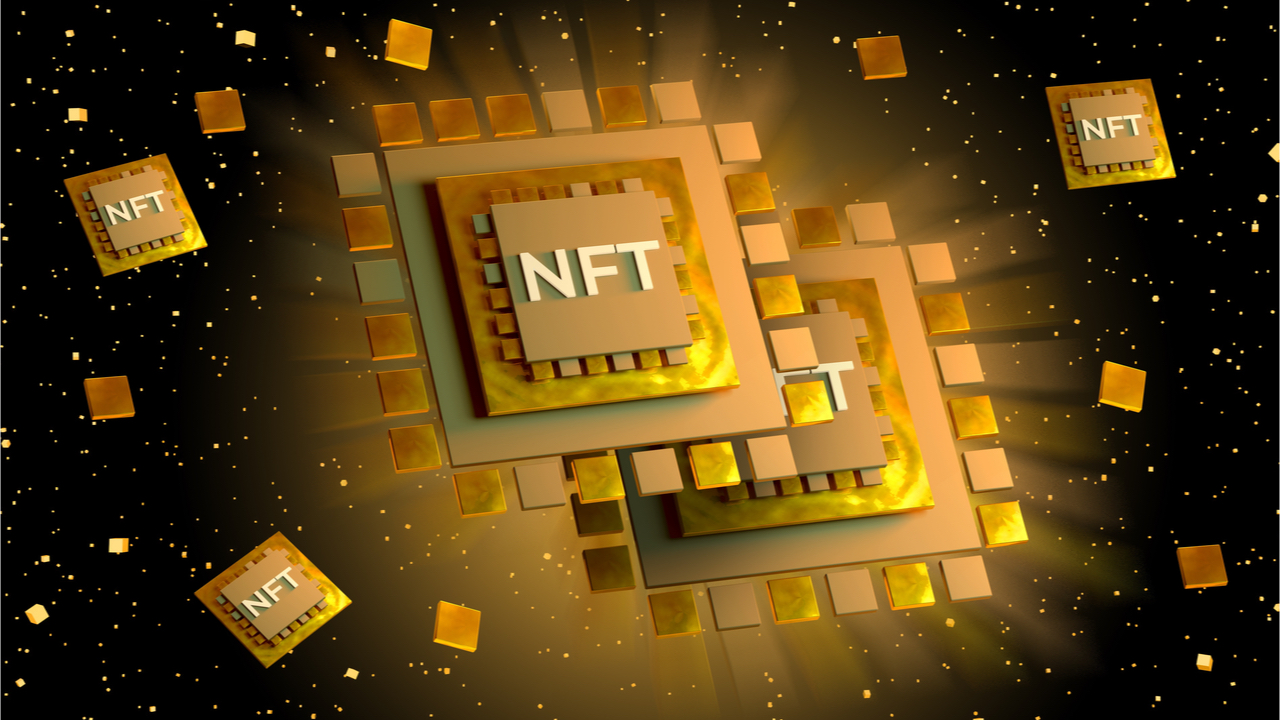 Non-fungible token (NFT) sales have increased this week after a small 2.15% drop the week prior. During the last seven days, NFT sales are up 34.62% from $579 million to $779 million. The NFT collection with the most sales this past week was Azuki, as the collection’s NFT sales jumped 94.68% higher than the week […]
Non-fungible token (NFT) sales have increased this week after a small 2.15% drop the week prior. During the last seven days, NFT sales are up 34.62% from $579 million to $779 million. The NFT collection with the most sales this past week was Azuki, as the collection’s NFT sales jumped 94.68% higher than the week […] On Sunday, April 3, the total value locked (TVL) in decentralized finance (defi) has risen to $231 billion. The TVL is nearing the all-time high (ATH) of $256 billion recorded on December 2, 2021, as it’s only 10.82% under the TVL’s ATH. Additionally, while Curve Finance continues to dominate in terms of TVL, the defi […]
On Sunday, April 3, the total value locked (TVL) in decentralized finance (defi) has risen to $231 billion. The TVL is nearing the all-time high (ATH) of $256 billion recorded on December 2, 2021, as it’s only 10.82% under the TVL’s ATH. Additionally, while Curve Finance continues to dominate in terms of TVL, the defi […] Last week, non-fungible token sales saw an improvement after tumbling week after week in terms of sales volume. This week, NFT sales are down 2.15% from last week’s $544.6 million to this week’s $539.2 million. The top NFT collection in terms of weekly sales was the Azuki compilation of collectibles, as the project saw a […]
Last week, non-fungible token sales saw an improvement after tumbling week after week in terms of sales volume. This week, NFT sales are down 2.15% from last week’s $544.6 million to this week’s $539.2 million. The top NFT collection in terms of weekly sales was the Azuki compilation of collectibles, as the project saw a […] After cryptocurrency assets jumped in value this week, following the Federal Reserve’s rate hike on Wednesday, non-fungible token (NFT) weekly sales volume data shows an improvement from last week’s sales metrics. At the time of writing, in terms of seven-day sales volume, the aggregate NFT sales volume increased by 17.86% this week to $457 million. […]
After cryptocurrency assets jumped in value this week, following the Federal Reserve’s rate hike on Wednesday, non-fungible token (NFT) weekly sales volume data shows an improvement from last week’s sales metrics. At the time of writing, in terms of seven-day sales volume, the aggregate NFT sales volume increased by 17.86% this week to $457 million. […]
A decentralized finance (DeFi) crypto asset that launched on the Binance Smart Chain (BSC) is surging even as the broader markets trade sideways. Xido Finance (XIDO) is an automated market maker (AMM) with a capped supply of 100,000,000 XIDO tokens that offers yield-farming incentives to liquidity providers. According to the AMM project’s whitepaper, “XIDO Finance […]
The post Overlooked Altcoin Erupts 170% in Matter of Days While Rest of Crypto Markets Stagnate appeared first on The Daily Hodl.
 The crypto-economy has been sliding in value during the last 48 hours as the current market valuation for all 13,000+ crypto assets is $1.83 trillion. Furthermore, the total value locked (TVL) in decentralized finance (defi) protocols has slipped below the $200 billion mark to $196.02 billion on Sunday morning (EST). Meanwhile, Ethereum’s dominance is 55.54% […]
The crypto-economy has been sliding in value during the last 48 hours as the current market valuation for all 13,000+ crypto assets is $1.83 trillion. Furthermore, the total value locked (TVL) in decentralized finance (defi) protocols has slipped below the $200 billion mark to $196.02 billion on Sunday morning (EST). Meanwhile, Ethereum’s dominance is 55.54% […] The total value locked in decentralized finance (defi) has managed to jump above the $200 billion zone, as crypto markets have rebounded from the market downturn last week. A number of native assets from the $611 billion worth of smart contract protocols have seen double-digit gains with cypherium (CPH), counterparty (XCP), and terra (LUNA) leading […]
The total value locked in decentralized finance (defi) has managed to jump above the $200 billion zone, as crypto markets have rebounded from the market downturn last week. A number of native assets from the $611 billion worth of smart contract protocols have seen double-digit gains with cypherium (CPH), counterparty (XCP), and terra (LUNA) leading […]
Avalanche blockchain launched its own official Ethereum bridge in 2021, but now a third-party cross-chain bridge claims to reduce transaction cost even further.
Avalanche (AVAX), a Layer-1 proof-of-stake (PoS) blockchain network, gets a new cross-chain bridge from Umbria Network to help traders transfer liquidity between Ethereum mainnet and the Avalanche blockchain.
Avalanche blockchain supports multiple virtual machines, including WebAssembly (WASM) and Ethereum Virtual Machine (EVM), allowing different sub-chains to incorporate a specific way of operations.
Multiple virtual machine support enables easy connection with Avalanche. The network launched its official Ethereum bridge in 2021 to allow the two-way transfer of ERC-20 and ERC-721 tokens across the two blockchains. But its growth as a network, along with its native token AVAX seeing serious gains over the last few months, led to the creation of third-party cross-chain bridges.
Narni, a new cross-chain bridge by the Umbria Network, promises to offer a 90% cheaper transaction fee compared to the official AVAX bridge. The platform claimed its bespoke system that uses single asset liquidity pools and a custom oracle protocol that reduces the computational complexity of bridging and thus reduces the cost by up to 90%.
Talking about the role of AVAX and cross-chain bridges, Barney Chambers, Co-founder and co-lead developer of Umbria, explained to Cointelegraph that the Avalanche blockchain allows decentralized applications that are not economically feasible on Ethereum. He added:
“Umbria is acting as the glue between all of the L1 and L2 blockchains, enabling users to move their assets in a cheap and timely manner. At Umbria, we envision that, in the future, users will not even need to know what blockchain they are using,”
Related: How Polkadot’s parachain auctions make a decentralized Web3 possible
Cross-chain bridges have become a lifeline for the decentralized finance ecosystem, especially when the gas fee issue on Ethereum fails to die down and seems it will remain persistent until the transition to ETH 2.0. Avalanche, BNB Chain, Solana and Tezos come forward as popular blockchains with a cross-chain bridge support.

Binance Smart Chain became quite popular as an Ethereum alternative during the latter's peak of network congestions and gas fee issues.
Decentralized blockchain ecosystem Binance Smart Chain (BSC) today announced that it is taking a new name, BNB Chain, in a bid to reflect its connection with the native token of the ecosystem Binance Coin (BNB).
According to the release, BNB now stands for "Build and Build" instead of short for Binance Coin. Powered by BNB, the BNB Chain would introduce advanced capabilities and focus on building Web3 infrastructure.
Under the freshly-named BNB Chain umbrella, the chain governance part, the Binance Chain, where staking and voting happens, has become BNB Beacon Chain. On the other hand, the EVM-compatible, multichain-supporting Binance Smart Chain is simply named BNB Smart Chain, still shortened as BSC.
The BNB Chain will bring all its Web3 development under the umbrella of MetaFi that will bring together developers and projects from the metaverse along with GameFi and SocialFi. The BNB Chain would bring large-scale applications and developer tools while expanding the validator set from 21 to 41 with a focus on scalability.
Related: Binance Invests $200M in Forbes to boost consumer knowledge on Bitcoin
Cointelegraph reached out to Binance for more info, and this article will be updated with the response.
Binance Smart Chain was launched in September 2020 as an alternative to Ethereum blockchain and mimicked the platform in its operation with a lower transaction cost and time of processing. In a short time span, BSC became a popular choice for DeFi developers and NFT projects due to ease of operations, interoperability and low cost. The rebranding comes as an attribute to the next leg of the journey that will combine DeFi and virtual reality in the metaverse.

The exploit took place on the Ethereum-BSC bridge that saw the hacker use $185 million as collateral to steal $80 million worth of tokens from lending pools.
The development team behind Bunny Finance and Qubit has decided to disband the protocol and turn it into a decentralized autonomous organization (DAO).
In an official medium post published on Friday, The Bunny Finance team announced that the exploit on Qubit that resulted in $80 million worth of loss has made it impossible for the team to operate at full scale. Thus, they have decided to disband the protocols and give authority to the community.
As reported earlier by Cointelegraph, the Qubit bridge called X-bridge facilitated tokens swaps from Ethereum (ETH) to Binance Smart Chain (BSC). The hacker behind the attack managed to exploit a "logical error” in the X-Bridge smart contract that allowed them to withdraw tokens on the BSC chain without depositing any on Ethereum.
— Qubit Finance (@QubitFin) January 28, 2022
The hacker managed to steal 77,162 qXETH worth $185 million and used it as collateral to borrow several assets from the lending pools worth $80 million. The borrowed tokens included 15,688 Wrapped Ether (wETH) worth $37.6 million, 767 BTC-B ($28.5 million), $9.5 million worth of stablecoin and $5 million worth of PancakeSwap (CAKE), Pancake Bunny (BUNNY) and MDX tokens.
Related: Wormhole token bridge loses $321M in largest hack so far in 2022
The official announcement noted that moving forward, the community will be in charge of major decision making including upgrading contracts, altering fee structure. In order to change the protocols to DAO, the development team has shut down vaults on Bunny which will no longer mint the native token. The team is also shutting down leveraged Farming Vaults and Single Asset Vaults on Qubit that were used to borrow assets.
The development team has also decided to discontinue major fee structures barring unstaking and compounding fees. The team would also launch a new market on Qubit and get rid of the old model that was hacked. All team tokens would be locked in a community smart contract and profits from the contract would be utilized as a compensation pool. The existing members of the team would participate as a member of the DAO.